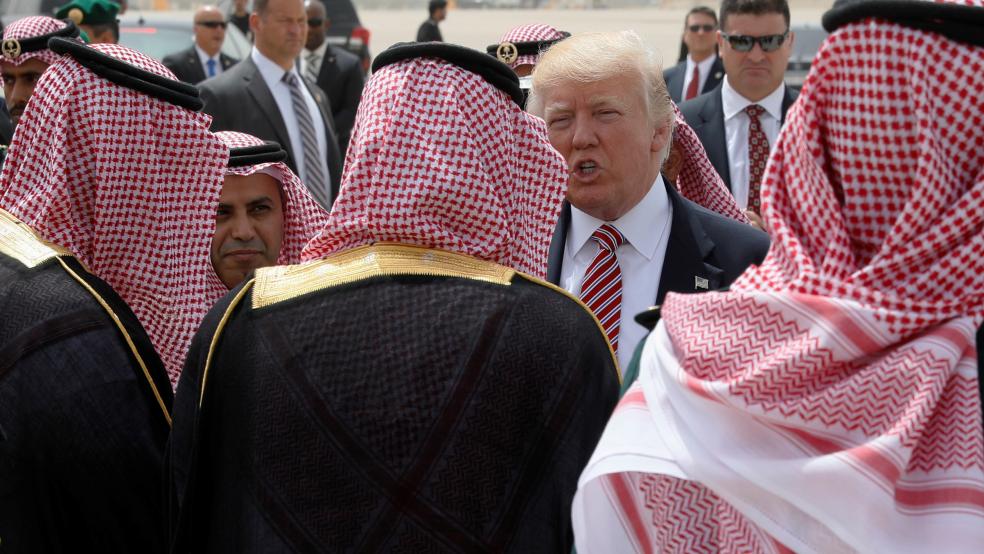It looks like the $110 billion arms deal with Saudi Arabia and promises of huge jobs gains that President Trump announced to great fanfare during his trip to the Middle East last month was seriously oversold.
At the time the deal was announced, Trump touted it as the largest arms deal in US history -- which it was if the numbers involved were taken at face value. “Tremendous investments in the United States,” Trump promised. “Hundreds of billions of dollars of investments into the United States and jobs, jobs, jobs.”
Related: How the US Lost Track of $2 Billion Worth of Weapons Sent to Fight ISIS
But even at the time, a close reading of the government’s official statements about the arrangement with the Saudis revealed that there was much less to the deal than met the eye. The State Department’s Defense Security Cooperation Agency, which has to approve foreign arms sales, included so many caveats in its official announcement that it seemed to leave open the possibility of no transaction actually taking place at all.
The announcement refers to “potential future defense capabilities” and “intended sales” that could end up “potentially supporting tens of thousands of new jobs in the United States.” Further, the $110 billion price tag, it turned out, was far from a solid number. In fact, according to DSCA, it represented the “maximum allowable case value” of the deals.
On Monday, the Pentagon announced another incremental step in implementing the Saudi deal, reporting that the “potential sale” of $1.4 billion in missile defense equipment and training packages had been approved. That’s about 1.3 percent of the $110 billion Trump announced while visiting Riyadh last month.
Also, on Monday, Bruce Riedel, a senior fellow and director of the Brookings Intelligence Project at the Brookings Institution, published a brief article on his organization’s website calling the entire narrative surrounding Trump’s deal with Saudi Arabia into question.
Related: 9 of the Oddest Moments from Trump’s First Foreign Trip
A 30-year veteran of the Central Intelligence Agency, who served in the Middle East for many years, Riedel argued that the arrangement with the Saudis is “fake news” that rests on the Trump administration overstating the ability of the Kingdom to pay for US armaments and repackaging deals that were struck not by Trump, but by the Obama administration.
“I’ve spoken to contacts in the defense business and on the Hill, and all of them say the same thing: There is no $110 billion deal. Instead, there are a bunch of letters of interest or intent, but not contracts. Many are offers that the defense industry thinks the Saudis will be interested in someday.”
Some of the big-ticket items were on the table for two years or more before Trump traveled to the Middle East last month.
- The sale of four frigates to the Saudi Navy was announced by the State Department in 2015. And, as Riedel notes, the ships proposed for sale are a version of an existing US Navy frigates that has never actually been produced.
Related: Does NATO Really Owe the US Money?
- The sale of 150 combat helicopters to the Saudis is, again, old news. The deal has been in the works, in various forms, since 2010.
- The sale of the Terminal High-Altitude Air Defense (THAAD) system, which appeared to move forward with Monday’s announcement, was approved by the Obama administration in 2015.
Riedel also points out that there is another very serious question about the $110 billion arrangement that isn’t being addressed: whether the Saudis can afford it.
“It’s unlikely that the Saudis could pay for a $110 billion deal any longer, due to low oil prices and the two-plus years old war in Yemen,” he writes. That’s especially true given what they have already spent in recent years. “President Obama sold the kingdom $112 billion in weapons over eight years, most of which was a single, huge deal in 2012 negotiated by then-Secretary of Defense Bob Gates,” he notes.
On Tuesday morning, the president was once again on Twitter, railing about the “FAKE” media. But it looks more and more as though the president is projecting his administration’s own problems onto his most convenient adversary.





